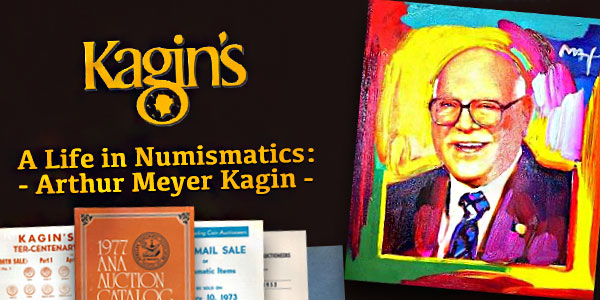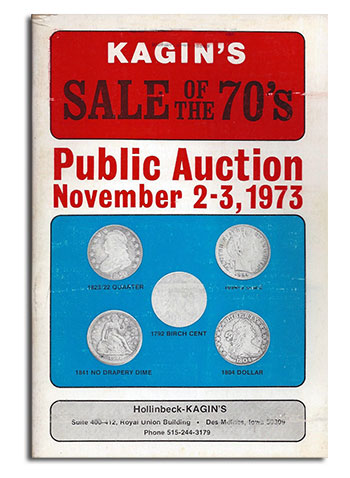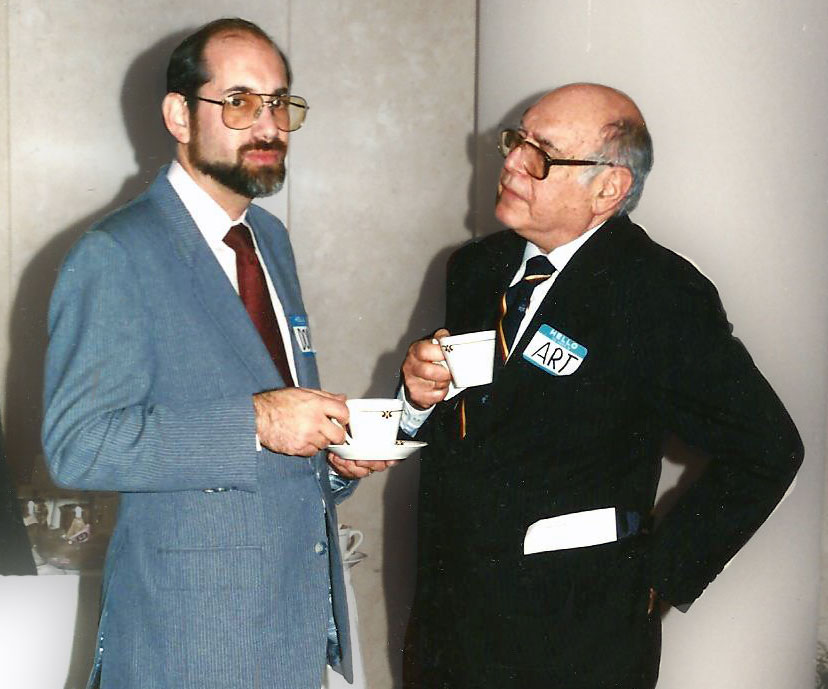
By David Thomason Alexander for CoinWeek….
For generations he was among America’s best-known professional numismatists and was widely eulogized upon his death on July 18, 2005. Arthur Meyer Kagin was born in Minneapolis on Nov. 25, 1919. His mother was widowed after the birth of his brother and long-time numismatic partner Paul in 1921. His parents had made the trans-Atlantic voyage from Russia with thousands of other Russian Jews during the great flood tide of immigration before the First World War.
A few family anecdotes recalled the long steamship voyage that went far south toward Cuba, where vendors approached in open boats, offering tropical fruits. Looking at a hand of fresh bananas, one of the Jewish passengers objected, “You can’t eat that! It’s traef,” (a Jewish expression meaning literally “filth,” i.e. not kosher for consumption by the Orthodox).
A lively debate ensued among the passengers including Art’s mother who was striving to remain faithful to the kosher laws. The realization that bananas were fruit ended the argument as fruit is nearly always kosher. His mother implanted in her sons a lifetime interest in Jewish education, history and tradition.
Most Jewish immigrants in that busy era settled in the East, notably in New York, but a number of more adventurous families settled in the Midwest, in cities such as Chicago and Milwaukee. Art’s mother went even further west, marrying a man named Schreiber in Omaha, Nebraska and presenting Art with two half-brothers later associated with the coin dealership to which he devoted his life. Since their last name was not Kagin, the Schreibers were not easily identified on the show circuit as family, often a useful situation.
Art was fond of telling the story of his introduction to the world of coins in 1928. He and each of his four brothers had separate corners where they each sold newspapers and magazines. Art told the story that once an older lady paid him with an 1883 No Cents Liberty head “V” nickel with instructions to keep it safe as it would one day be worth far more than five cents, since it lacked the word ‘cents’. This anecdote was the origin of the cryptic “Art Kagin – since 1928” that appeared for decades under his photograph in Kagin ads in The Numismatist and Numismatic Scrapbook magazines.
Art took a momentous step at age 13, going to work for R.O. Hollinbeck Stamp & Coin in Minneapolis in 1933. Starting as a weekend and summer worker, he went full time in 1935. He rose with amazing speed, assuming heavy responsibilities for a teenager, opening Hollinbeck stores in Omaha and in 1936 in Des Moines, Iowa, where he would remain for a lifetime.
New York was then the center of commercial numismatics in the U.S., with some major dealers and auction houses to be found in Boston and Philadelphia. Both Saint Louis and Chicago were home to prominent dealers and there were a few nationally known figures operating in far more obscure hamlets, such as Milferd H. Bolender in Orangeburg, Illinois.
It should be remembered that Dr. George F. Heath of Monroe, Michigan, conceived the American Numismatic Association as the vehicle to encourage and support small-town collectors living far from such few numismatic societies as then existed. These were what New York Numismatic Club historian Dr. John M. Kleeberg has called the “small town intelligentsia” of doctors and lawyers located out in the hinterland.
Des Moines was a city of good size, a state capital and railroad hub. It was also a growing business and financial center, home to so many insurance companies that it drew the nickname “the Hartford of the West.” Cost of living was more reasonable than New York and in short order, Art Kagin placed it on the numismatic map.
The Great Depression launched thousands of Americans into coin collecting, especially after J.K. Post of Neenah, Wisconsin, created the first “penny boards” later acquired and perfected by Whitman Publishing of Racine. However dismal the economy might be, nearly everyone could set aside a few Lincoln cents to fill the holes in these inexpensive boards and resell the filled boards to local coin dealers.
Art’s Des Moines store sold more than 50,000 boards annually and distributed thousands more through five-and-ten-cent stores, even barber shops and drug stores. Iowa coin clubs now proliferated from zero in the 1920’s to 20 in 1938, when the Iowa Numismatic Association was formed as the first state organization in the U.S. In 1940 the Central States Numismatic Society was created with Art’s active participation.
Art’s younger brother Paul joined the firm in 1940, but the name Hollinbeck Stamp and Coin Company continued to be used for decades after sale of the firm to the Kagins. In part this name was preserved for its familiarity to customers, but there was a second reason relating to a dark reality in American life at that time: it didn’t “sound Jewish.” Anti-Semitism was a pervasive undercurrent in pre-war America and there were many businesses whose names were chosen with this in mind.
In Kagin’s heyday, Art handled the numismatics, Paul ran the all-important business operations and administered the mail bid sales for which their firm would become famous. Technically these were not auctions, as there was no live bidding in these sales. All bids were submitted in writing and tabulated in the Kagin’s offices in the Royal Union building in downtown Des Moines.
In 1943-1944 the brothers served in the U.S. Army. They joined at different times in order to keep the business open. Paul would send Art coins to catalogue, and Art would catalogue on his off hours and send the pages and coins back to Paul to run the auction. Returning to civilian life, they were pleasantly surprised to see the increase in value of their carefully stored inventory that had taken place during the war years.
Art married Henrietta Spitz in February 1945. They had two sons and a daughter, the youngest, Donald (born Sept. 22, 1950) would become prominent among American coin dealers.
Returning to business, Kagin’s began conducting sales almost monthly from 1946 through 1956. When historic auction catalog collecting began to gain popularity in the 1970’s, collectors found many mysteries in compiling lists and trying to find Kagin catalogs for their collections. Striving to include all Kagin sales, compiler Martin Gengerke listed 347 through May 1988. The elder statesman of American auction literature, Boston’s John W. Adams, selectively describes 307 sales through July 1975.
 There is a vast stretch of time and quality between today’s auction catalogs and those of 60-70 years ago. Kagin catalogs of the 1940’s and 1950’s were 6 x 9-inch paperbacks, generally around 50 pages in length, Few if any had illustrations or cover art. A very few included halftones cut from the pages of Wayte Raymond’s Standard Catalogue of United States Coins, illustrating the date or type, not the actual coin on offer.
There is a vast stretch of time and quality between today’s auction catalogs and those of 60-70 years ago. Kagin catalogs of the 1940’s and 1950’s were 6 x 9-inch paperbacks, generally around 50 pages in length, Few if any had illustrations or cover art. A very few included halftones cut from the pages of Wayte Raymond’s Standard Catalogue of United States Coins, illustrating the date or type, not the actual coin on offer.
Examining a typical catalog, Sale 91, Nov. 20, 1950, we find a tan cover with a line drawing of a Continental dollar and 12 lines of black imprint in seven lettering styles; terms of sale occupy the inside cover complete with offering a prices realized list at 50 cents per copy.
Coins are listed with adjectival grading and estimates from Standard Catalogue of United States Coins prices or “present market values.” Listings may include such laconic notices as “List $9 unc.” or Worth $2.50.” Neither Large cents nor other early U.S. coins are given variety reference numbers. “Foreign Silver and Gold” include crowns and minors without estimates or reference numbers though Wayte Raymond’s Coins of the World was then the standard reference.
The Kagins had a long association with U.S. paper money and this sale went from “CURRENCY – LEGALS to SMALL SIZE FEDERALS. Rivalry in the field of U.S. paper, still in its infancy, was fierce and the Kagins’ success bothered competitors including the late Chuck O’Donnell who was still fighting this fight at the time of his death decades later. The back cover is occupied by an ad for the 1951 Guide Book of U.S. Coins, the “Red Book.”
By the 1970’s “Meet the Catalogers” had been introduced with halftones of Art and brother Paul, though the latter was never active as a cataloger. Covers now bore the disclaimer “This is A Mail Sale, There Is No Floor Competition.” Reference numbers to Sheldon on large cents, Judd on Patterns, Overton on half dollars were being introduced along with Friedberg numbers for U.S. paper currency.
Art’s youngest son Don joined the firm full time in 1972. The year 1973 saw far-reaching change. What was billed as the “Ter-Centenary Sale, Part I” in April included a set of pale red U.S. gold dollar photos on the front cover. The firm name is given as Hollinbeck KAGIN Coin Company and “Meet the Catalogers” now includes a third photo, Don Kagin. There are still no lot photos inside the 64 page catalog.
 The Nov. 2-3, 1973 introduced a revolution, billed as Kagin’s Sale of the 70’s, Public Auction with three-color cover bearing halftones of five U.S. rarities. The text now explodes with a variety of typefaces, light- and boldface, plain and italic, liberally sprinkled with exclamation points like buckshot for added emphasis.
The Nov. 2-3, 1973 introduced a revolution, billed as Kagin’s Sale of the 70’s, Public Auction with three-color cover bearing halftones of five U.S. rarities. The text now explodes with a variety of typefaces, light- and boldface, plain and italic, liberally sprinkled with exclamation points like buckshot for added emphasis.
The November sale was held in Harrisburg, Pa., at the convention of the Middle Atlantic Numismatic Association (MANA). For the first time, seven black and white plates of exceptionally poor visual quality were included along with a very few dropped-in photos “of the actual items sold.”
Highlights included a rare 1841 No Drapery dime, 1792 Birch Cent and an 1894-S Barber Dime and a silver plated copper electrotype 1804 Silver Dollar made in the Philadelphia mint by W.E. DuBois.
Art and his son Don wanted to expand into the public auctions arena while Paul wished to stay a small mail bid firm so in 1974 Paul and Art separated and Don assumed many of Paul’s duties. The new company was called Art & Don Kagin, Inc.
Kagin’s now landed the 1977 American Numismatic Association (ANA) Convention sale, long one of the most desirable opportunities for major dealers. ANA catalogs are key units of any numismatic library and provide valued links in the pedigree chains of many a great rarity, though Kagin’s was long notorious for omitting pedigree data whenever possible to disguise multiple appearances of the same coin.
This writer was very familiar with Kagin’s 1977 ANA catalog for the largest convention sale ever that was called in Atlanta, Ga. That catalog was composed of five small volumes and was printed by Amos Press Inc. of Sidney, Ohio, publishers of Coin World. Art flew the legendary Walter Breen to Des Moines, accommodating him in the family home to get his input in the cataloging.
Art insisted that Coin World’s own photographer fly to Des Moines, shoot many of the 5,700-odd lots and bring home the film for processing. Color art was made by colorizing clear black and white photos to look like gold, silver or bronze.
Regrettably, the photographer neglected to number his pictures and fell while carrying them, spilling hundreds of finished pictures over the dark room floor. The present writer and Tom DeLorey of “Collectors’ Clearinghouse” then had to plunge it, trying to re-match and identify this mass of photos from the frequently overblown descriptions.

The five mini-volumes then refused to fit into their pre-ordered orange and black box-covers, which had to be remade with more nerve-wracking delay. The catalogs were finally sent out by the most expensive methods to assure delivery.
Kagin’s also conducted the 1983 ANA Sale in San Diego, CA, which for the first time featured a cover—“Lady Liberty”– by a world renowned artist, Peter Max. Art was still the main cataloger but Don now directed the rapidly expanding firm’s destinies, including expansion of a nationwide network of “investment” coins to be offered through financial planners.
Vast change came to Kagin catalogs, many initiated when “Mr. Red Book” Ken Bressett was associated with the firm Numerical grading on the Sheldon scale was extended to all U.S. denominations in the style of the American Numismatic Association Certification Service (ANACS), including both numerical and adjectival grades.
ANACS adjectival descriptions were not those used in the coin marketplace. Coins might be “MS-63 Select Uncirculated; Choice Proof-65; or MS-65 Choice Brilliant Uncirculated.” On the commercial market, however, ‘63 coins were called Choice and ’65 pieces were referred to as Gem. No one else used “Select.”
The ANA sale and succeeding sale catalogs increased in size to 11 x 8-1/2 inches.
In 1981 Don opened a San Francisco Office on his own while Art stayed in Des Moines concentrating on buying and selling paper currency, especially National Bank notes.
In 1986 Kagin’s was awarded its third ANA auction, but changes in the industry including strong competition in the auction field and legal challenges in the financial planning area, led to closing down the auction company in 1988 and the consolidation of all Kagin’s Inc. operations in California.
Throughout the years Art was awarded numerous honors including the American Numismatic Association’s highest award, the Farran Zerbe for distinguished service in 2000. In 1997 his daughter, Judith, joined him. They both split time working in the Des Moines office and with Don in Tiburon, California. Having two of his children sharing his passion for numismatics was one of his greatest joys.
Art survived the death of his wife Henrietta, finally succumbing to acute leukemia in Des Moines on July 18, 2005. His passing was mourned by friends and sometime competitors with a remarkable outpouring of respect and grief.
Since then, Don has continued to grow the Kagin’s brand. Kagin’s still operates out of California, it’s home office in Tiburon, and continues to seek out major coins and consignments. In 2014, the firm catapulted to international fame when it announced the discovery of the Saddle Ridge Hoard, a major cache of uncirculated gold coins in California.





A very well-written and revealing history – but what else would you expect from master writer Dave Alexander?
I knew Art well for decades and he was sharp as a tack until the day he passed away at an old age. No dementia here. He was a delight to deal with, always wearing a rumpled suit and tie – he particularly liked exonumia. Paul – I met exactly once in my 58 yrs in the hobby – he had a table on his own at the 1976 NYC ANA.
Chuck Long
Art was kind to my wife and I when I was a struggling young dealer in Des Moines in the 1980’s. I remember he set up next to us at a coin show and was telling us he saw the most beautiful tree on the drive over and he and his wife stopped and took pictures of that tree. David was also very kind to us and he even wrote an article about us for Coin World and he gave us such a good deal and I still fondly remember that interaction. We have since moved to Minnesota in the 1990’s and by God’s grace we specialize in world paper money and US Mpc’s on eBay under ShipwreckedGiftShop.